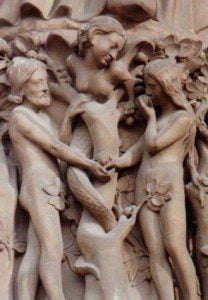 Last Tuesday I put up a summary (No Historical Adam?) of Denis Lamoureux’s chapter in the new book from the Zondervan Counterpoints series: Four Views on the Historical Adam. Denis presents a view that we should recognize the Adam story as an accommodation to an ancient Near Eastern understanding of human origins. In today’s post we will look at the responses offered by the other three contributors, John Walton, Jack Collins, and William Barrick, and at the rejoinder offered by Denis Lamoureux.
Last Tuesday I put up a summary (No Historical Adam?) of Denis Lamoureux’s chapter in the new book from the Zondervan Counterpoints series: Four Views on the Historical Adam. Denis presents a view that we should recognize the Adam story as an accommodation to an ancient Near Eastern understanding of human origins. In today’s post we will look at the responses offered by the other three contributors, John Walton, Jack Collins, and William Barrick, and at the rejoinder offered by Denis Lamoureux.
John Walton’s main points of disagreement come with the rather black and white way that Denis constructs his argument. He agrees that there is accommodation in Scripture and that “concordism is hermeneutically suspect.” He has noted in the past that there is no new science in Scripture (the purpose is not to reveal science). He believes that Denis oversteps when he jumps from ancient Near Eastern ideas about the origin of life and the origin of humans to the conclusion that there was no historical Adam.
Because the account of the creation of Adam contains elements that come from an ancient Near Eastern understanding of origins Lamoureux states “And since ancient science does not align with physical reality, it follows that Adam never existed.” On this point Walton replies:
I disagree that his conclusion follows inevitably from his observation. It does not follow that Adam never existed; only that the forming account does not record the forming of a single unique individual.(p. 68)
Lamoureux also argues that consistency of interpretation, recognizing ancient views of astronomy in the origin of the heavens suggests that we should recognize ancient science-of-the-day in the origin of Adam. Here Walton responds:
Even if the “forming” narrative about Adam has some parallels in the ancient Near East, that does not prove that Adam is not a real person in a real past. At most it would indicate that the forming account may be an accommodation – that does not mean that the role of Adam is an accommodation. After all there is no one with the role of Adam in the ancient Near East. (p. 68)
Walton also disagrees with the way Lamoureux deals with Jesus’s reference to Genesis 1-2 and to Paul’s use of Adam in the New Testament. I think the argument concerning the way Jesus references Genesis 1-2 is a dead end trail in the discussion of the historicity of Adam and I’ve written on this before (Jesus on Adam and Eve). Lamoureux could, perhaps, make the point more clearly but Walton’s criticism is off the main point as well.
Paul’s use of Adam in Romans 5 and 1 Corinthians 15 are more significant sticking points. Lamoureux doesn’t dig deeply into the theological significance of Adam here and Walton challenges him: “The question is not whether Paul believed that Adam was a real person. Paul believed many things that (in our estimation) were not true about the natural world. The question is whether Paul invested theological significance in his belief.” (p. 69)
C. John Collins also agrees with a number of the points made by Lamoureux, but thinks he has followed a style of reasoning that is oversimplified. Lamoureux sees either-or options where Collins would prefer to explore the possibility that there are other alternatives or some middle ground. Collins doesn’t think that talk about “ancient science” is the best way to refer to the kind of language we find in Genesis 1-3 or in many other places in Scripture preferring the category “ordinary language.” He concludes:
Actually, we cannot tell, one way or the other, simply from the words used, exactly what the writers “believed” about the world. For the most part, it doesn’t even matter: these authors successfully refer to the things they describe – and enable us to picture them – without making any kind of strong claim about the processes. As near as I can tell, the age and shape of the earth play no role in anyone’s communication in the Bible. (p. 75)
The reason for this is that the age and shape of the earth simply were not questions they thought about at any significant level.
On a theological level, Collins doesn’t think that the truths Lamoureux sees in his application of the Message-Incident principle “do adequate justice to the overarching narrative element in the Bible.” Most importantly: “The Bible as a whole, not just Genesis, portrays sin as something that at some point made an entrance into God’s good world, but does not belong here and will one day be eradicated.” (p. 79)
William Barrick’s critique of Lamoureux is a little hard to deal with. He takes a young earth view and finds Lamoureux’s account troubling on many levels. He makes the argument that “Questioning the accuracy of one part of scripture always puts the whole of Scripture in doubt.” (p. 80) He points out that Calvin and Luther held to a young earth and that modern evangelicals holding any form of an old-earth are taking a path contrary to such long-trusted commentators and theologians. He makes the point that it is inconsistent to accept some miracles but not others – for example it is inconsistent to accept water to wine at Cana but not the special creation of Adam. He is also concerned with the difficulty of establishing “the sinfulness of all mankind without exception” if Adam and Eve are not the unique historical parents of the human race. These are not surprising points. We must deal with the nature of scripture as trustworthy and “able to make [us] wise for salvation through faith in Christ Jesus” and with the long history of biblical interpretation that accepted a young earth.
How Barrick elaborates his concerns is somewhat befuddling to me. I’ll give only a couple of examples here.
Barrick objects to Lamoureux’s use of Psalm 139:13-14 (For you created my inmost being; you knit me together in my mother’s womb. I praise you because I am fearfully and wonderfully made) as an example that there is no necessary distinction between “natural” processes that take time and the handiwork of God. According to Barrick:
Such procreative processes, however, do not appear to offer an equivalent parallel. According to Scripture, God did not form Adam in a preexisting mother’s womb. Genesis depicts an instantaneous special creation of one individual, Adam, from the dust of the earth. God made Eve by an equally instantaneous and special creation.
I argue that Adam bears no resemblance to the legend of Rip van Winkle, who slept for years and awoke to find a world changed by the passing of time. For Eve to have evolved out of Adam would have taken millions of years. Adam could not have slept for eons of time while God made the woman. It would require the multiplication of many miracles to keep Adam from aging while we waited for a wife to evolve. (p. 81)
I have not got a clue where this last paragraph comes from. It is, quite frankly, incoherent and seems lacking in logical structure unless I am missing something not stated. The male and the female cannot evolve separately.
In his chapter Lamoureux pointed out that Jesus told the parable of the mustard seed calling it the smallest of all seeds (Mark 4:31), used an illustration of the death of a seed before germination (John 12:23-24), and describes stars falling from the sky (Matthew 24:27,29). All of these represent ancient misunderstandings of science in some fashion – but Jesus’s point wasn’t to teach science and the illustrations make his point to his hearers quite beautifully. Barrick jumps on this:
The parables that Jesus used in teaching the multitudes and his disciples could be his own observations of real-life people and their experiences. Lamoureux assumes that they are made up or are like old wives’ tales passed on from ancient times. It is as though Jesus could not observe and think for himself, but merely parroted traditional stories and axioms. In other words, Jesus did not raise the standard of theological consideration, but rather adopted the lower standards of the pagan world around him. (p. 83)
I don’t see how Barrick gets this from Lamoureux’s chapter at all. Lamoureux certainly does think that Jesus could observe and think for himself and that Jesus did raise the standard of theological consideration. The critique simply misses the point and uses what appears to be intentionally inflammatory language without really addressing the issue at hand.
I could pick up a couple of other examples – but this probably gives the picture well enough. Barrick appears convinced that all who hold to evolutionary creation (with or without a historical Adam) base their “conclusions on a full, unquestioning faith in secular evolutionary theory” (p. 84) and are leading young people astray.
Denis Lamoureux responds briefly to the points raised by Walton and Collins in his rejoinder to finish this first section of the book. He points out that he and both Walton and Collins have many points of agreement. He finds the questions that Walton raises concerning Jesus’s reference to Adam and marriage somewhat inconsistent and has no objection to the terminology of “ordinary language” that Collins prefers. He is disappointed by Barrick’s response – as, quite frankly, am I.
And a summary thought. I agree with John Walton and Jack Collins that Denis makes the alternatives too stark an either – or and that his logic is not always as conclusive as he makes it appear. His position is one valid alternative, but it may or may not be the best alternative. My current thinking on the question of Adam is closer to the position that Denis describes than to any of the others in the book. However, I think we need to put on the table some of the positions Denis dismisses; positions that accept evolutionary creation and include a historical Adam of one sort or another. This whole question needs more hard work in conversation between Christian scholars and thinkers. Although I find much that I agree with in Denis’s discussion of the presence of ancient “science” in the text, I don’t think he has (yet) dealt adequately with the theological questions raised in Paul. I also think that Denis might push the idea of accommodation a bit too hard and that Jack’s suggestion of “ordinary language” nuances the idea in a useful direction.
What do you think?
What questions would you raise regarding evolutionary creation without a historical Adam?
If you wish to contact me directly, you may do so at rjs4mail[at]att.net
If interested you can subscribe to a full text feed of my posts at Musings on Science and Theology.











